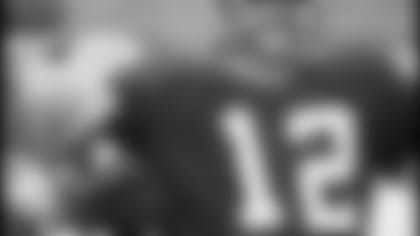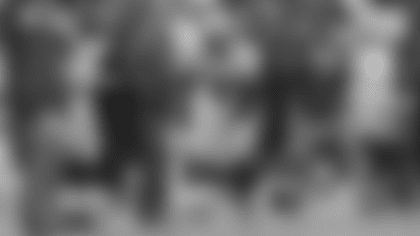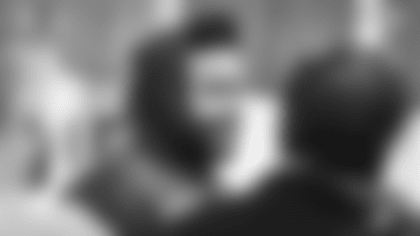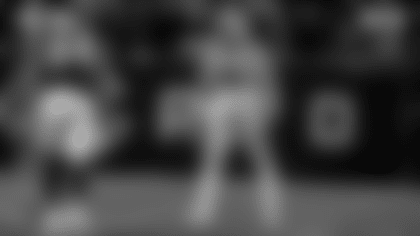GREATEST COMEBACK IN PACKERS HISTORY, KEY WESTERN CONFERENCE PLAYOFF HIGHLIGHT 7-DECADE SERIES WITH RAMS
The Packers and the St. Louis Rams, who will make mutual history next week when they meet on the "Monday Night Football" showcase for the first time, have forged more than a few historic adventures over the course of their seven-decade "association."
Curiously, two of the most memorable occurred in Milwaukee - at County Stadium, the Packers' second home from 1953-1994, which since has fallen to the wrecking ball.
Chief among them, without question, was a critical 28-7 victory over the Rams in a 1967 Western Conference playoff which propelled the Packers into the fabled "Ice Bowl" against the Dallas Cowboys, played in Lambeau Field just eight days later.
Close behind, from the historical perspective, was a salutary happening on Sept. 12, 1982.
The Green and Gold, down 23-0 at halftime, proceeded to execute the most dramatic comeback in team annals, erupting for 35 consecutive unanswered points in the second half to depart County Stadium with a 35-23 victory.
From the overall standpoint, the Packers dominated the early years of the series, launched in 1937 when the Rams were based in Cleveland, winning 12 and tying one of the first 14 games (they also have won five of the last seven meetings). But the Rams caught up during the '50s and today lead the series, having won 44 games to the Packers' 39.
There also have been two ties - the most recent a 24-24 standoff at the Los Angeles Memorial Coliseum in 1964 (the Rams became the NFL's first West Coast team when they moved to Los Angeles in 1946).
In addition, there recently has been a second playoff game, a divisional showdown in which the Rams posted a 45-17 victory at St. Louis on Jan. 20, 2002 (The Rams had moved to St. Louis in 1995).
The '67 playoff contest matched the Packers, champions of the NFL's Central Division (9-4-1) and the Rams, the Coastal Division champions (11-1-2), to determine the winner of the Western Conference title. The survivors would advance to the NFL Championship Game against Dallas in what became the "Ice Bowl."
On that occasion, things were more than somewhat chancy for the Packers in the early going, which saw the Rams move out to a 7-0 first quarter lead by way of a 29-yard Roman Gabriel scoring pass to Bernie Casey.
To compound the problem, the Rams again threatened to score early in the second quarter when defensive back Chuck Lamson waylaid a Bart Starr pass and returned it to Green Bay's 10-yard-line.
Fortuitously, premier pass rusher Henry Jordan sacked Gabriel for a 7-yard loss on third down, forcing Los Angeles to attempt a field goal by Bruce Gossett, an effort which was blocked by linebacker Dave Robinson.
One exchange later, rookie running back Travis Williams, who had become a sensation at mid-season, broke into the open over the right side and streaked 46 yards to the end zone, Don Chandler adding the extra point to tie the score at 7.
The Rams also came up empty on their next possession, Gossett's 46-yard field goal attempt falling short, and the Packers' Willie Wood staked the Green and Gold to prime field position, returning the failed kick 44 yards to the Green Bay 45.
From there, Starr had the Packers in the end zone in 7 plays, firing a 17-yard, third-down strike to wide receiver Carroll Dale for the score. Chandler's conversion made it 14-7 at the intermission.
Taking over the game in the second half, the Packers scored on a 4-yard run by running back Chuck Mercein in the third quarter and a 2-yard run by Williams in the fourth quarter while a tightfisted defense continued to hold the Rams scoreless the rest of the way.
One of the most significant victories in team annals, it set the stage for the Packers to make NFL history by becoming the only team to win three consecutive league championships since the advent of the playoff system in 1933 by defeating the Cowboys for the '67 title in the "Ice Bowl," 21-17.
Behind the scenes, the scheduling of the back-to-back post-season contests spoke volumes about Lombardi's confidence in himself and his football team. As the Packers' general manager, he had assigned the first playoff to Milwaukee, sure in his own mind that the Green and Gold would be in the NFL Championship Game - in Green Bay - eight days later.
The subsequent "comeback classic" in '82 was much like two very different games, with the Rams converting three first half turnovers into 13 points en route to that 23-0 intermission lead.
Overall, two lost fumbles and two Rams interceptions contributed substantially to the Packers' scoreless state at halftime, a point at which they had a modest 66 net yards to show for their efforts.
But things were dramatically different in the second half. Quarterback Lynn Dickey began to hit his receivers with admirable frequency and the defense collaborated by restricting the Rams to "three-and-out" on their first two third-quarter possessions.
After the first such defensive intervention, Dickey guided the Packers 55 yards to their first touchdown of the afternoon, hitting tight end Paul Coffman with a 4-yard strike for the score.
The Green and Gold were even more expeditious on the second possession of the period, winging 47 yards in three plays for the touchdown, set up by Dickey's 42-yard "bomb" to Coffman, which positioned the Packers at the 3-yard line. From there, halfback Eddie Lee Ivery burst into the end zone over right tackle on the next play. And. after Jan Stenerud's second conversion, it was a more reassuring 23-14, but still a long way to go.
A series of four "three-and-outs," two by each team, and a third Dickey interception subsequently intervened before the Packers engineered a decisive breakthrough early in the fourth quarter.
Taking over at their own 34 after Rams placekicker Mike Lansford 's 51-yard field goal attempt veered wide left, Dickey had the home forces in the end zone in four plays, the score coming on a 15-yard pass to wide receiver James Lofton. Stenerud's conversion pared the Rams' lead to two points, 23-21.
Then, right on the heels of that highly favorable development, Rams returner Kermit Alexander fumbled the succeeding kickoff and the Packers' Guy Prather recovered at the Los Angeles 10-yard line.
Dickey needed only one play from there, finding Coffman in the heart of the end zone for the score and sending the Packers into the lead for the first time at the 3:48 mark of the final period.
The suddenly embattled Rams responded with a pair of first downs following the next kickoff but an 8-yard Mike Butler sack of L.A. quarterback Bert Jones stalled the drive.
One exchange later, Packers linebacker George Cumby intercepted a Jones pass and the Packers promptly set about the finishing touches.
Ivery opened the 66-yard drive modestly enough with a 2-yard gain, after which Dickey hit Coffman with a 10-yard pass and running back Mike Meade broke through the middle for a 19-yard advance, "improved" by a 5-yard face mask penalty on the Rams.
Meade next hit left tackle for 3 yards, setting the stage for Ivery to bolt up the middle on a 27-yard draw for the game's final touchdown with 3:06 remaining in the game.
Stenerud then added the Packers' 35th consecutive, unanswered point with his fifth conversion, completing the most remarkable comeback in team annals.
Continuing an association with the team that is more than 55 years old, Lee Remmel was named the first official Team Historian of the Green Bay Packers in February 2004. The former *Green Bay Press-Gazette reporter and Packers public relations director, Remmel will write regular columns for Packers.com as part of his new assignment.
In addition to those articles, Remmel will answer fan questions in a monthly Q&A column. To submit a question to Remmel, click here. *














